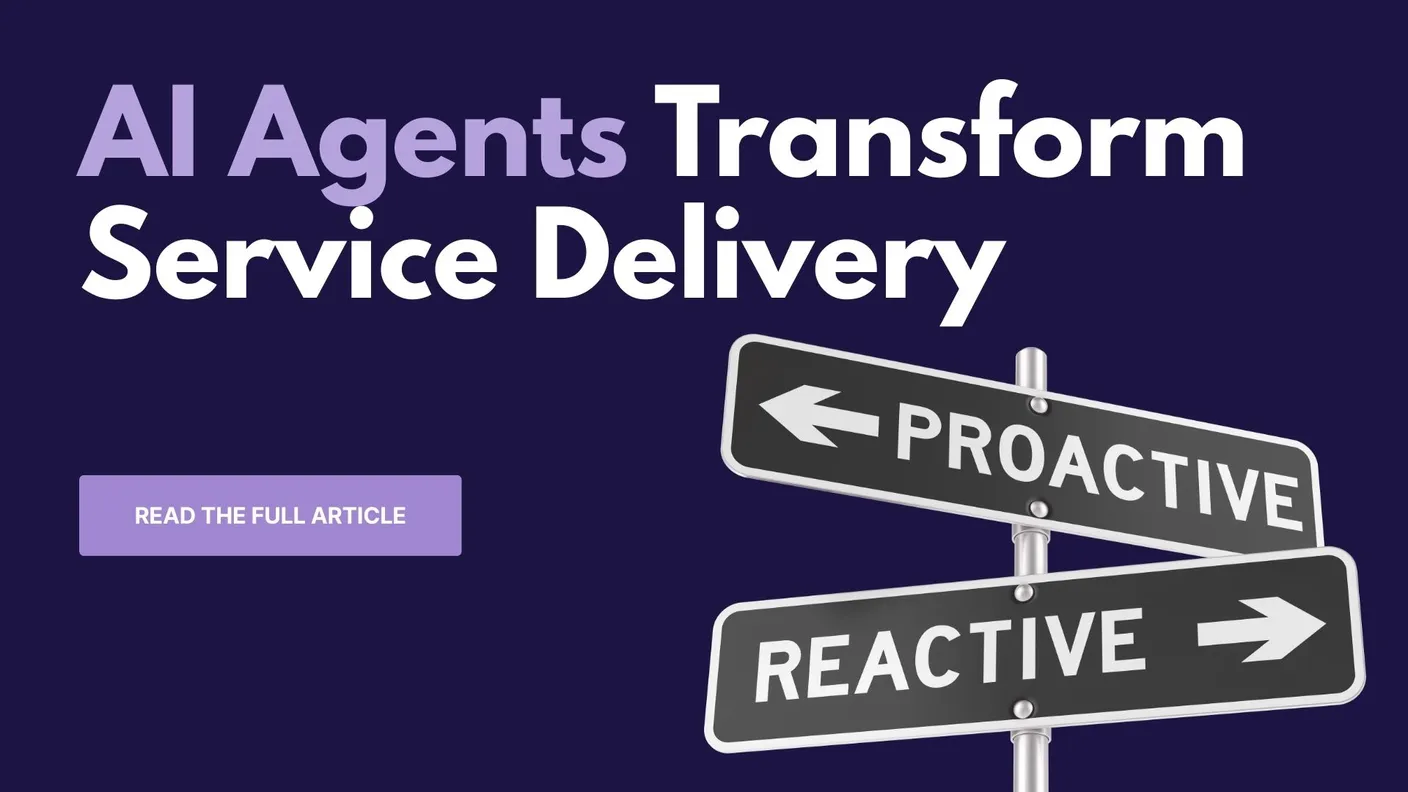From Reactive to Proactive: How AI Agents Transform MSP Service Delivery


For decades, managed service providers have operated in reactive mode: Waiting for problems to occur, then scrambling to fix them. This firefighting approach is exhausting for technicians, frustrating for clients, and ultimately unsustainable in today’s always-on business environment. AI agents are changing this paradigm, enabling MSPs to predict and prevent issues before they impact clients.
The Traditional Reactive MSP Model: A Cycle of Frustration
Before exploring how AI transforms service delivery, let’s examine the limitations of traditional reactive approaches.
The Reactive Service Cycle
In the traditional model, MSP service delivery follows a predictable but problematic pattern:
- Problem Occurs: A server crashes, application fails, or security breach happens
- Client Discovers Issue: Often after significant business impact
- Ticket Creation: Client reports the problem, sometimes hours after occurrence
- Triage and Assignment: Human staff reads, categorizes, and assigns the ticket
- Investigation: Technician diagnoses the root cause
- Resolution: Fix is implemented and tested
- Documentation: Details are recorded for future reference
This cycle has several inherent problems:
- Downtime is Inevitable: Problems must occur before they’re addressed
- Client Frustration: Business operations are disrupted
- Resource Intensive: Requires significant technician time for each incident
- Unpredictable Workload: Support requests come in waves
- Limited Learning: Same issues often recur across different clients
The Hidden Costs of Reactive Support
Operating reactively carries significant costs beyond the obvious:
- Technician Burnout: Constant firefighting leads to stress and turnover
- Client Churn: Frustrated clients seek more proactive providers
- Opportunity Costs: Time spent on emergencies prevents strategic work
- Reputation Damage: Outages harm both client and MSP credibility
- Revenue Impact: Emergency rates don’t compensate for lost client trust
CAUTION
Research from Kaseya shows that MSPs operating primarily in reactive mode experience 40% higher technician turnover and 25% lower client retention rates compared to those with proactive capabilities.
The AI-Powered Proactive Model: Preventing Problems Before They Occur
AI agents fundamentally change the service delivery paradigm by enabling true proactive support. Instead of waiting for problems, AI agents continuously monitor, analyze, and act to prevent issues from ever impacting clients.
Predictive Issue Detection
AI agents use sophisticated pattern recognition to identify problems before they manifest:
System Performance Analysis
- Baseline Establishment: AI agents learn normal performance patterns for each client’s environment
- Anomaly Detection: Subtle deviations from baseline trigger investigation
- Trend Analysis: Gradual degradation is identified before users notice
- Correlation Discovery: AI identifies relationships between seemingly unrelated metrics
For example, an AI agent might notice that CPU usage on a database server increases by 2% each week. While humans might miss this gradual change, the AI predicts the server will reach critical levels in 6 weeks and recommends optimization before any impact occurs.
Predictive Failure Analysis
AI agents analyze historical data to predict hardware and software failures:
- Hardware Health Scoring: Combining multiple indicators to assess component reliability
- Software Stability Tracking: Identifying applications prone to crashes
- Environmental Factors: Considering temperature, power quality, and other conditions
- Vendor Intelligence: Incorporating known issues from manufacturer databases
TIP
ConnectWise reports that MSPs using AI-driven predictive analytics reduce unexpected hardware failures by 60% and software-related incidents by 45%.
Self-Healing Workflows
Perhaps the most transformative capability of AI agents is their ability to automatically resolve issues without human intervention:
Automated Remediation
When AI agents detect issues, they can immediately:
- Restart Services: Automatically restart hung processes or services
- Clear Cache: Remove temporary files causing performance issues
- Reallocate Resources: Adjust CPU, memory, or storage allocation
- Apply Patches: Deploy critical updates during maintenance windows
- Rollback Changes: Revert problematic updates or configurations
Intelligent Decision Trees
AI agents follow sophisticated logic to determine appropriate actions:
- Issue Detection: Anomaly identified through monitoring
- Impact Assessment: Determine potential business impact
- Solution Selection: Choose from available remediation options
- Risk Evaluation: Assess potential side effects
- Action Execution: Implement the solution
- Verification: Confirm issue resolution
- Learning: Update knowledge base with outcome
Safe Automation Boundaries
AI agents operate within carefully defined parameters:
- Approval Workflows: High-risk actions require human authorization
- Rollback Capabilities: All changes can be reversed if needed
- Audit Trails: Complete documentation of all automated actions
- Escalation Triggers: Complex issues automatically alert humans
Real-World Impact: 25% Reduction in Incidents
The shift from reactive to proactive service delivery produces measurable results across key performance indicators.
Incident Reduction Metrics
MSPs implementing AI-driven proactive support report:
- 25% Overall Incident Reduction: Fewer problems reach the point of impacting users
- 40% Decrease in Severity 1 Incidents: Critical issues are particularly well-prevented
- 50% Reduction in Repeat Incidents: Self-healing workflows prevent recurrence
- 35% Fewer After-Hours Calls: Proactive maintenance reduces emergency situations
Operational Efficiency Gains
Beyond incident reduction, proactive AI agents deliver:
- 60% Faster Issue Resolution: Problems caught early are easier to fix
- 70% Reduction in Manual Monitoring: AI agents handle routine checks
- 45% Less Time on Root Cause Analysis: AI provides immediate insights
- 80% Automation of Routine Fixes: Common issues resolve automatically
INFO
Pax8’s 2024 MSP Success Report indicates that proactive MSPs achieve 2.5x higher revenue per technician compared to reactive providers.
Staffing Transformation: 30% Cost Reduction Through 24/7 AI Support
The proactive model, powered by AI agents, fundamentally changes MSP staffing requirements and costs.
Reduced Emergency Staffing Needs
Traditional MSPs must maintain expensive on-call rotations:
- After-Hours Coverage: Premium pay for night and weekend shifts
- Escalation Chains: Multiple technicians on standby
- Geographic Coverage: Staff in different time zones
- Burnout Mitigation: Larger teams to prevent exhaustion
AI agents eliminate much of this overhead by:
- Handling Routine Issues 24/7: No human intervention needed
- Intelligent Escalation: Only truly complex issues require humans
- Global Coverage: One AI system serves all time zones
- Consistent Performance: No fatigue or performance degradation
Optimized Technician Utilization
With AI handling routine and predictive tasks, human technicians focus on:
- Strategic Projects: Infrastructure improvements and optimization
- Client Relationships: Proactive business reviews and planning
- Complex Problem Solving: Issues requiring creativity and expertise
- Innovation: Developing new services and solutions
This shift results in:
- 30% Reduction in Staffing Costs: Fewer technicians needed for same coverage
- Higher Job Satisfaction: Technicians work on interesting challenges
- Improved Retention: Less burnout leads to longer tenure
- Better Client Outcomes: Skilled humans focus on high-value activities
Comparing Traditional Reactive vs. AI-Enhanced Proactive Models
Let’s examine specific scenarios to illustrate the dramatic differences between reactive and proactive approaches:
Scenario 1: Database Performance Degradation
Traditional Reactive Approach:
- Database gradually slows over weeks
- Users complain about application performance
- Ticket created after business impact
- Technician investigates for 2-3 hours
- Identifies index fragmentation issue
- Schedules maintenance window
- Fixes issue after 3-5 days of degraded performance
AI-Enhanced Proactive Approach:
- AI detects 5% weekly performance degradation
- Predicts critical slowdown in 3 weeks
- Automatically schedules index optimization
- Performs maintenance during low-usage period
- Verifies performance improvement
- No user impact, no ticket created
Scenario 2: Security Threat Detection
Traditional Reactive Approach:
- Malware infiltrates network
- Spreads to multiple systems
- Data exfiltration begins
- Unusual activity eventually noticed
- Security team investigates
- Incident response activated
- Damage assessment and recovery
AI-Enhanced Proactive Approach:
- AI detects anomalous network behavior
- Identifies suspicious process attempting lateral movement
- Immediately isolates affected system
- Blocks malicious IP addresses
- Alerts security team with full context
- Threat neutralized before spread
Scenario 3: Storage Capacity Management
Traditional Reactive Approach:
- Storage fills gradually
- System hits critical threshold
- Applications begin failing
- Emergency ticket created
- Technician adds storage urgently
- Service restored after outage
AI-Enhanced Proactive Approach:
- AI tracks storage consumption patterns
- Predicts capacity exhaustion date
- Recommends optimal expansion timing
- Automated approval workflow initiated
- Storage expanded during maintenance window
- Seamless capacity increase with no impact
Implementation Roadmap: Making the Transition
Transforming from reactive to proactive service delivery requires careful planning and execution:
Phase 1: Foundation Building (Months 1-2)
- Assess Current State: Document existing reactive processes
- Identify Quick Wins: Find easily automated tasks
- Select AI Platform: Choose tools aligned with your stack
- Pilot Program: Start with one client or service area
Phase 2: AI Deployment (Months 3-4)
- Deploy Monitoring: Implement comprehensive AI monitoring
- Configure Baselines: Let AI learn normal patterns
- Create Workflows: Build initial self-healing processes
- Train Team: Ensure technicians understand new model
Phase 3: Optimization (Months 5-6)
- Expand Coverage: Roll out to more clients
- Refine Automation: Improve self-healing accuracy
- Measure Impact: Track incident reduction metrics
- Gather Feedback: Incorporate team and client input
Phase 4: Full Transformation (Months 7-12)
- Complete Migration: All clients on proactive model
- Advanced Capabilities: Implement predictive analytics
- Service Evolution: Develop new proactive offerings
- Continuous Improvement: Regular optimization cycles
The Future of Proactive MSP Services
As AI technology continues to advance, the possibilities for proactive service delivery expand:
Emerging Capabilities
- Predictive Business Impact Analysis: AI will forecast how IT issues affect business outcomes
- Automated Compliance Management: Continuous monitoring and remediation of compliance gaps
- Intelligent Capacity Planning: AI-driven recommendations for infrastructure investments
- Ecosystem Orchestration: Coordination across multi-vendor environments
Competitive Advantages
MSPs embracing AI-driven proactive models will:
- Command premium pricing for superior service
- Attract clients seeking business transformation
- Operate with industry-leading efficiency
- Build sustainable, scalable businesses
TIP
According to ConnectWise’s MSP benchmark study, proactive MSPs command 35% higher margins and grow 2x faster than reactive competitors.
Conclusion
The transformation from reactive to proactive service delivery represents more than a technological upgrade, it’s a fundamental reimagining of how MSPs create value for clients. AI agents make this transformation possible by providing predictive issue detection that prevents problems before they occur and self-healing workflows that resolve issues automatically.
The measurable benefits are compelling: 25% reduction in incidents, 30% lower staffing costs, and dramatically improved client satisfaction. But beyond the metrics, the shift to proactive service delivery allows MSPs to focus on strategic value creation rather than endless firefighting.
As the MSP industry continues to evolve, the gap between reactive and proactive providers will only widen. Those who embrace AI-driven transformation today will be the market leaders of tomorrow, delivering exceptional value to clients while building more profitable, sustainable businesses.
The question isn’t whether to make this transition, but how quickly you can begin. The tools exist, the benefits are proven, and your clients are waiting for the proactive service they deserve.
Ready to transform your MSP with proactive service delivery? Discover how our AI agent solution enables predictive issue detection and automated resolution.